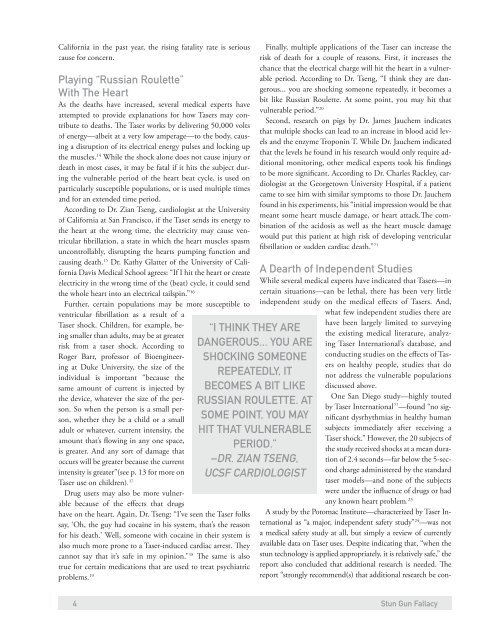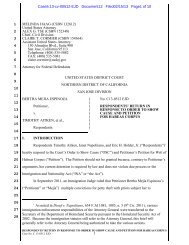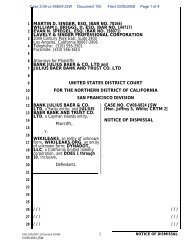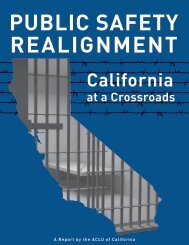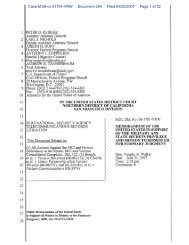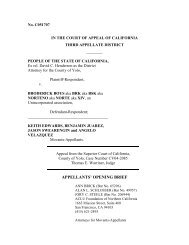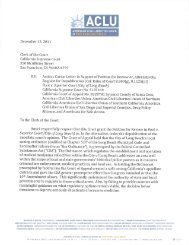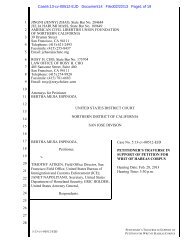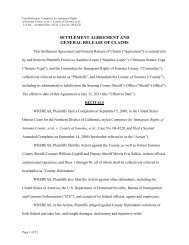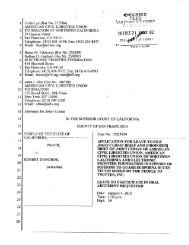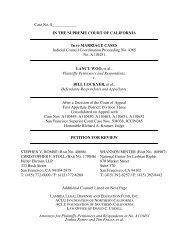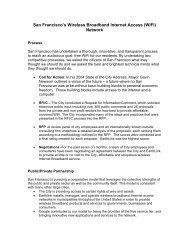Stun Gun Fallacy - ACLU of Northern California
Stun Gun Fallacy - ACLU of Northern California
Stun Gun Fallacy - ACLU of Northern California
Create successful ePaper yourself
Turn your PDF publications into a flip-book with our unique Google optimized e-Paper software.
<strong>California</strong> in the past year, the rising fatality rate is serious<br />
cause for concern.<br />
Playing “Russian Roulette”<br />
With The Heart<br />
As the deaths have increased, several medical experts have<br />
attempted to provide explanations for how Tasers may contribute<br />
to deaths. The Taser works by delivering 50,000 volts<br />
<strong>of</strong> energy—albeit at a very low amperage—to the body, causing<br />
a disruption <strong>of</strong> its electrical energy pulses and locking up<br />
the muscles. 14 While the shock alone does not cause injury or<br />
death in most cases, it may be fatal if it hits the subject during<br />
the vulnerable period <strong>of</strong> the heart beat cycle, is used on<br />
particularly susceptible populations, or is used multiple times<br />
and for an extended time period.<br />
According to Dr. Zian Tseng, cardiologist at the University<br />
<strong>of</strong> <strong>California</strong> at San Francisco, if the Taser sends its energy to<br />
the heart at the wrong time, the electricity may cause ventricular<br />
fibrillation, a state in which the heart muscles spasm<br />
uncontrollably, disrupting the hearts pumping function and<br />
causing death. 15 Dr. Kathy Glatter <strong>of</strong> the University <strong>of</strong> <strong>California</strong><br />
Davis Medical School agrees: “If I hit the heart or create<br />
electricity in the wrong time <strong>of</strong> the (beat) cycle, it could send<br />
the whole heart into an electrical tailspin.” 16<br />
Further, certain populations may be more susceptible to<br />
ventricular fibrillation as a result <strong>of</strong> a<br />
Taser shock. Children, for example, being<br />
smaller than adults, may be at greater<br />
risk from a taser shock. According to<br />
Roger Barr, pr<strong>of</strong>essor <strong>of</strong> Bioengineering<br />
at Duke University, the size <strong>of</strong> the<br />
individual is important “because the<br />
same amount <strong>of</strong> current is injected by<br />
the device, whatever the size <strong>of</strong> the person.<br />
So when the person is a small person,<br />
whether they be a child or a small<br />
adult or whatever, current intensity, the<br />
amount that’s flowing in any one space,<br />
is greater. And any sort <strong>of</strong> damage that<br />
occurs will be greater because the current<br />
intensity is greater”(see p. 13 for more on<br />
Taser use on children). 17<br />
Drug users may also be more vulnerable<br />
because <strong>of</strong> the effects that drugs<br />
have on the heart. Again, Dr. Tseng: “I’ve seen the Taser folks<br />
say, ‘Oh, the guy had cocaine in his system, that’s the reason<br />
for his death.’ Well, someone with cocaine in their system is<br />
also much more prone to a Taser-induced cardiac arrest. They<br />
cannot say that it’s safe in my opinion.” 18 The same is also<br />
true for certain medications that are used to treat psychiatric<br />
problems. 19<br />
“I THINK THEY ARE<br />
DANGEROUS... YOU ARE<br />
SHOCKING SOMEONE<br />
REPEATEDLY, IT<br />
BECOMES A BIT LIKE<br />
RUSSIAN ROULETTE. AT<br />
SOME POINT, YOU MAY<br />
HIT THAT VULNERABLE<br />
PERIOD.”<br />
–DR. ZIAN TSENG,<br />
UCSF CARDIOLOGIST<br />
Finally, multiple applications <strong>of</strong> the Taser can increase the<br />
risk <strong>of</strong> death for a couple <strong>of</strong> reasons. First, it increases the<br />
chance that the electrical charge will hit the heart in a vulnerable<br />
period. According to Dr. Tseng, “I think they are dangerous...<br />
you are shocking someone repeatedly, it becomes a<br />
bit like Russian Roulette. At some point, you may hit that<br />
vulnerable period.” 20<br />
Second, research on pigs by Dr. James Jauchem indicates<br />
that multiple shocks can lead to an increase in blood acid levels<br />
and the enzyme Troponin T. While Dr. Jauchem indicated<br />
that the levels he found in his research would only require additional<br />
monitoring, other medical experts took his findings<br />
to be more significant. According to Dr. Charles Rackley, cardiologist<br />
at the Georgetown University Hospital, if a patient<br />
came to see him with similar symptoms to those Dr. Jauchem<br />
found in his experiments, his “initial impression would be that<br />
meant some heart muscle damage, or heart attack.The combination<br />
<strong>of</strong> the acidosis as well as the heart muscle damage<br />
would put this patient at high risk <strong>of</strong> developing ventricular<br />
fibrillation or sudden cardiac death.” 21<br />
A Dearth <strong>of</strong> Independent Studies<br />
While several medical experts have indicated that Tasers—in<br />
certain situations—can be lethal, there has been very little<br />
independent study on the medical effects <strong>of</strong> Tasers. And,<br />
what few independent studies there are<br />
have been largely limited to surveying<br />
the existing medical literature, analyzing<br />
Taser International’s database, and<br />
conducting studies on the effects <strong>of</strong> Tasers<br />
on healthy people, studies that do<br />
not address the vulnerable populations<br />
discussed above.<br />
One San Diego study—highly touted<br />
by Taser International 22 —found “no significant<br />
dysrhythmias in healthy human<br />
subjects immediately after receiving a<br />
Taser shock.” However, the 20 subjects <strong>of</strong><br />
the study received shocks at a mean duration<br />
<strong>of</strong> 2.4 seconds—far below the 5-second<br />
charge administered by the standard<br />
taser models—and none <strong>of</strong> the subjects<br />
were under the influence <strong>of</strong> drugs or had<br />
any known heart problem. 23<br />
A study by the Potomac Institute—characterized by Taser International<br />
as “a major, independent safety study” 24 —was not<br />
a medical safety study at all, but simply a review <strong>of</strong> currently<br />
available data on Taser uses. Despite indicating that, “when the<br />
stun technology is applied appropriately, it is relatively safe,” the<br />
report also concluded that additional research is needed. The<br />
report “strongly recommend(s) that additional research be con-<br />
4 <strong>Stun</strong> <strong>Gun</strong> <strong>Fallacy</strong>


